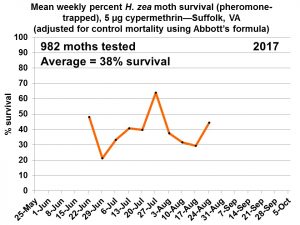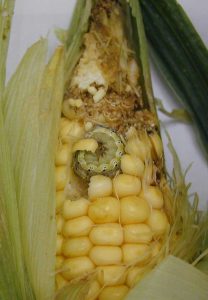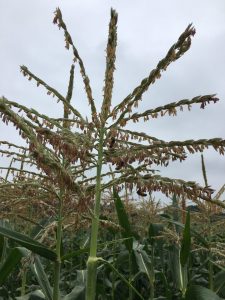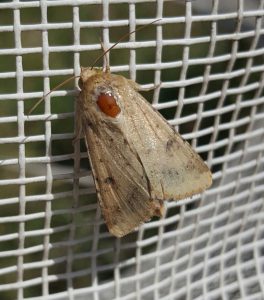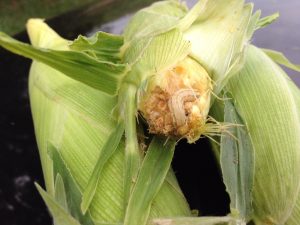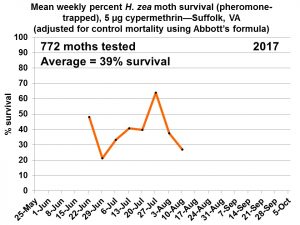According with the FSA, 26,323 acres of peanut were planted this year in Virginia; and the crop progresses well so far. The early May planted peanuts are getting close to the full seed growth stage (two pictures of peanut pods and seed are provided here)
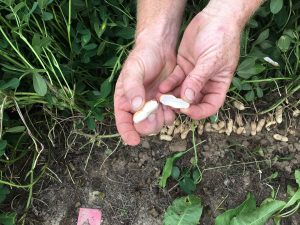
Peanut pod and seed at full seed stage.
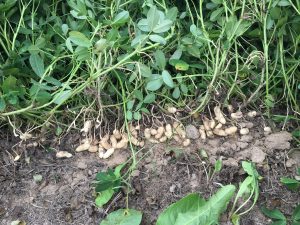
Peanut plants and pods on Aug-7-17 and planted in early May.
.
However, in some sandy fields plants have become yellowish lately. It is difficult to guess the reason for the yellow color. It could be caused by poor inoculation or nitrogen fixing due to drought or water standing; manganese deficiency, which is relatively easy to identify (a picture of manganese deficiency is provided here)
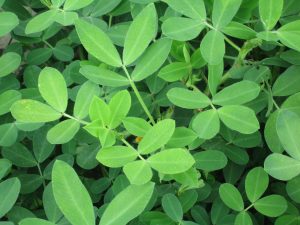
Peanut leaves with manganese deficiency.
; but also acidic soils, which are predominant in south-eastern Virginia. Soil pH directly affects plant growth through its effects on the availability of all nutrients. For example, soils with pH less than 6 may become deficient in calcium, magnesium, phosphorus, potassium, and molybdenum. Molybdenum is essential in biological nitrogen fixation and, even though the nodule numbers may seem sufficient, the result, tissue nitrogen content, may be limited. Gypsum does not alter soil pH; only lime can be used for that, and dolomitic limestone is the desired product as it provides calcium and magnesium. The traditional recommended pH range for peanut land is 5.8 to 6.2, but more towards 6.2 when Virginia-type peanuts are planted. In addition, limestone moves very slowly into the soil, therefore applying limestone early in the planting process and tilling it into the root zone (top 7 inches) is important. Rainfall amount, application of fertilizers containing ammonium or urea, sulfur containing ingredients, and decomposition of organic matter (previous crop residue) also adds to soil acidity. Soil sampling should be taken in the fall and, if the test results indicate a need for limestone, for best results it should be applied in the fall or winter months. If applied just prior to planting and soil is dry, lime will have little effect on the pH.
Going back to the yellow plant color, the best approach for knowing and not just guessing what causes it is to take soil and tissue samples and send to a laboratory for determining the soil pH and tissue nutrient content. The table below shows the sufficiency levels for macro and micronutrients of the peanut vines. It is recommended that 50 whole shoots throughout the field, or problematic areas, should be combined in one sample prior to or at bloom stage.
|
Macronutrients
%
|
Micronutrients
ppm
|
| Nitrogen (N) |
3.50-4.50 |
Iron (Fe) |
60-300 |
| Phosphorus (P) |
0.25-0.50 |
Manganese (Mn) |
60-350 |
| Potassium (K) |
1.70-3.00 |
Boron (B) |
25-60 |
| Calcium (Ca) |
1.25-2.00 |
Copper (Cu) |
5-20 |
| Magnesium (Mg) |
0.30-0.80 |
Zinc (Zn) |
25-60 |
| Sulfur (S) |
0.20-0.35 |
Molybdenum (Mo) |
0.10-5.00 |
Manganese (1 pound per acre) and boron (up to 0.5 pounds per acre) are regular applications in peanut production during summer, but nitrogen can also be applied if the tissue analysis indicates the need. Rate of 60 to 120 pounds per acre elemental nitrogen (or 285 to 571 pounds per acre of ammonium sulfate) can be applied, depending on the test results; and it is worth applying even at this time (August). After all, there are two more months of peanut growth. Increasingly more fields seem to require potash applications. Peanut is efficient at scavenging phosphorus and potassium left in the soil from previous crops, but for some reason potassium is getting slim each year. An application of 100 pounds per acre of potash may correct that deficiency.
Knowing the history of each field for yield and crop growth, can help to anticipate where nutritional problems may occur and allow for preventive measures even before symptoms are visible. Drone technology can be used to derive soil maps for pH, moisture and yield of each crop in rotation, so that precise locations within a field where problematic spots exist can be known and independently managed using the variable rate technology (VRT). The VRT consists of a control system on an application equipment, planters, sprayers, and spreaders, which allows grower to achieve site-specific application rates of inputs. To work, prescription maps need to be generated and uploaded to the computer within the machine cab that has the VRT. Drones can be used to generated these maps. For example, the last picture in this story shows an image of the soil moisture distribution of a field at the Tidewater AREC. The image was taken before peanut planting with an infra-red camera on a drone; the drone purchased not long ago with funding from the Virginia Peanut Board, the shellers, and Virginia Crop Improvement Association. In the image, the darker the blue the more soil water was available; green color indicated dryer soil sections with the driest spots being colored in yellow and red and located in the patches adjacent to the field.
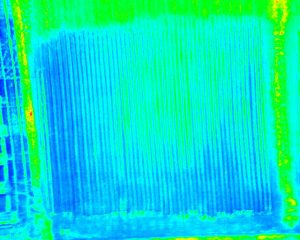
Pre-plant field image taken with an infra-red camera from a drone showing soil moisture distribution.
Potential applications of this technology can help growers to use variable seeding rates and depths depending on the available soil moisture at planting, and monitor irrigation needs throughout the growing season.

